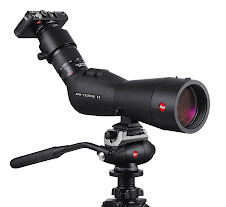



As the sun sank below the horizon I was hoping for a green flash or similar when I had yet another unusual sighting.
 Canada Goose wrapped in reflected sunlight
Canada Goose wrapped in reflected sunlight
The brilliant reddish-orange sunlight reflected off the water and framed Canada Geese sitting at the shore in a cool brilliant halo or aura. Unfortunately, I was not able to capture this as vividly as it appeared to my eye, perhaps due to the scope coatings designed to control stray or reflected light?!?... I don't know, but it was still neat to see and I couldn't ever remember seeing this effect so vividly.
I'd been enjoying great photo ops all day and had been lucky/quick enough to capture 2 odd sightings in a row. I should have known my luck would soon change. After digiscoping yet another Eastern Phoebe and a male Pine Warbler, I laid my scope across the back seat and my trusty point & shoot on the passenger side floor. I continued down the main park road passing the canoe & kayak launch, viewing Northern Mockingbirds and Brown Thrashers teed up at roadside, eventually reaching the proverbial "end of the road".
It was near 4 PM and the road ahead went from pavement to gravel/shell and the sign here instructed that this was accessible by employees only. As I prepared to turn around I looked out the driver's side window. A bird perched on a low fence near 40 feet away, lifted off and flew directly away up a small slope. The lighting was perfect and I noted a pale gray back and contrastingly dark tail that was splayed out and slightly notched. The bird hung and wind hovered for a bit before dropping to the ground. The shape, and color pattern struck a familiar chord and I knew that bird wouldn't be likely here so I quickly glassed it.
I noted the relatively uniform light gray head and upper back, before it lifted off and flew directly back to perch on the short fence. My initial suspicions were confirmed as I saw the unmistakable peachy underparts of a Say's Phoebe! It was so close, I was certain it would spook if I stepped out. Instead, I turned and detached my scope from the tripod in the back seat and was beginning to attach it to the car window mount when my luck ran out. The bird lifted off and paralleled the river here. With a strong wind to its back, the bird quickly drifted further and further away... 100... 200 yards then it swept across a side channel and dropped out of sight behind a large white house.
It appeared the bird had landed but my view was blocked by the taller stream side vegetation here. I spent the next few minutes looking for lingering birders but only dog walkers and folks coming in for an evening meeting of sorts.... not a binocular in sight. I tried calling the few birder's numbers I had, leaving message after message but it was time to go. I reluctantly loaded up and headed back under the tunnel to catch my flight. A good bird seen but unfortunately not confirmed.
Worse yet I had been unable to share this rarity with any locals and with light fading and no one contacted it was unlikely anyone would even get a chance to find it until the following morning. It was neat seeing a bird like this far out of its normal range, but I'd seen Say's on both of last two trips to Monterey & Colorado respectively. I know from past experience what an exciting experience seeing this bird would have been to most in the local community.
C'est la vie! You win some, you lose some. The score this time was Birds 1, Birder zero. Still win or lose, I always enjoy playing the game and had a wonderful day on the shores of Mobile Bay!





i think i asked you this before, but i dont know if i received an answer or not. why do you choose digiscoping over a regular dslr with large lens attached?
ReplyDeleteresahattic - the answer for me is EZ actually,priorities. I'm more of a birder than I am photographer so am going to carry my scope always as viewing is a higher priority than photographing birds. With a DSLR setup, to have any realistic expectations of consistent bird images one likely needs a 400 mm telephoto or larger. Even a decent 400 mm (say an f/8) & DSLR can weigh up to 6 pounds in weight and 15 inches or more in length for starters. If you move to an f/5.6 or even f/4 now your talking 20+ pounds and >2 foot long lens. Personally, I'm not willing to carry both, and candidly am not willing to give up my scope for quality views and study of the wildlife I see.
ReplyDeleteSure, in this case if I'd had a DSLR on the seat with this bird at 30' away I would have gotten an image that was good enough for ID likely filling about one fifth of the frame. However, if the bird had stayed - which I suspected due to the bird's behavior of foraging contently like the Eastern Phoebes here - my digiscoping setup begins at a 1,000 mm equivalent and goes up to a 3,000 mm equivalent so the image would have been stunning. I was shocked when the silly thing took off and flew so far actually or I would have snapped off an image with just my point & shoot alone for starters!